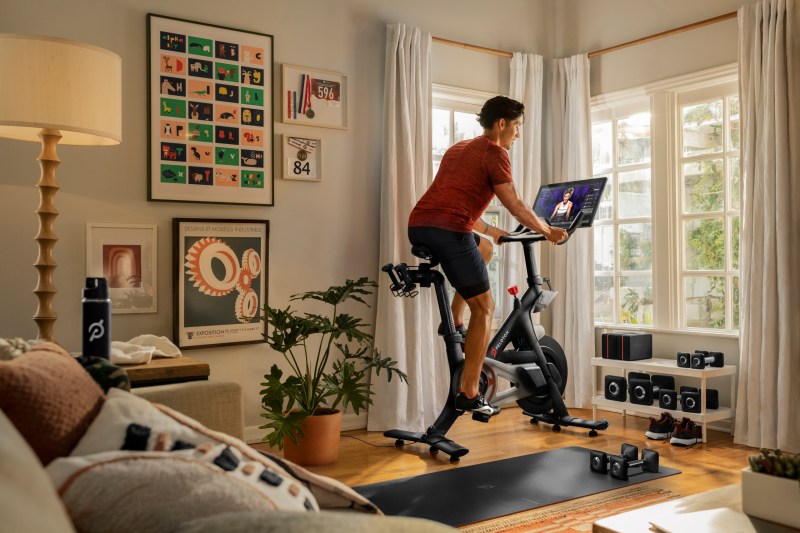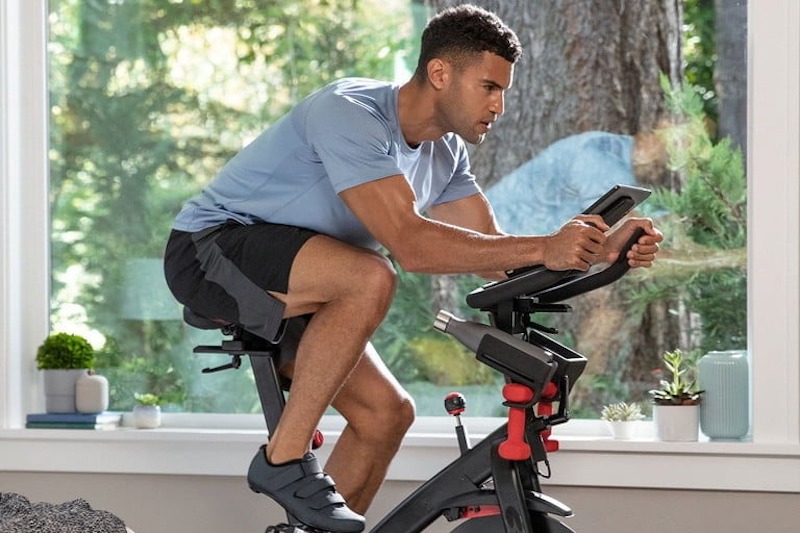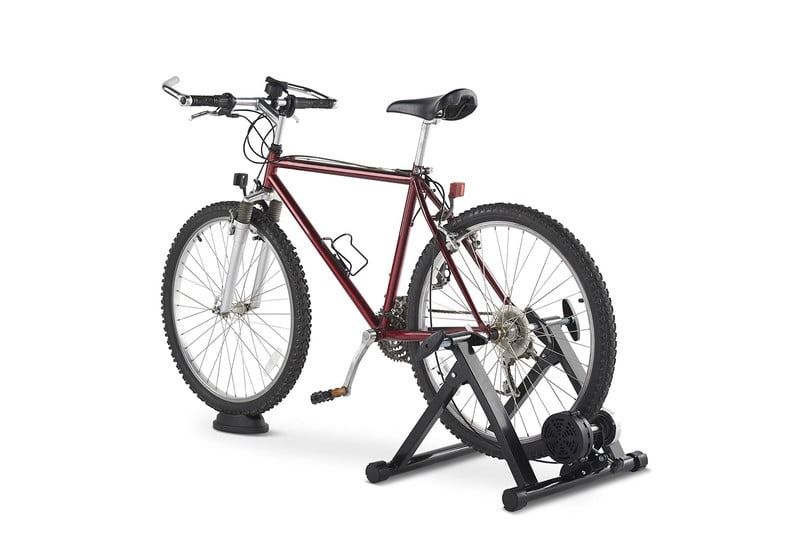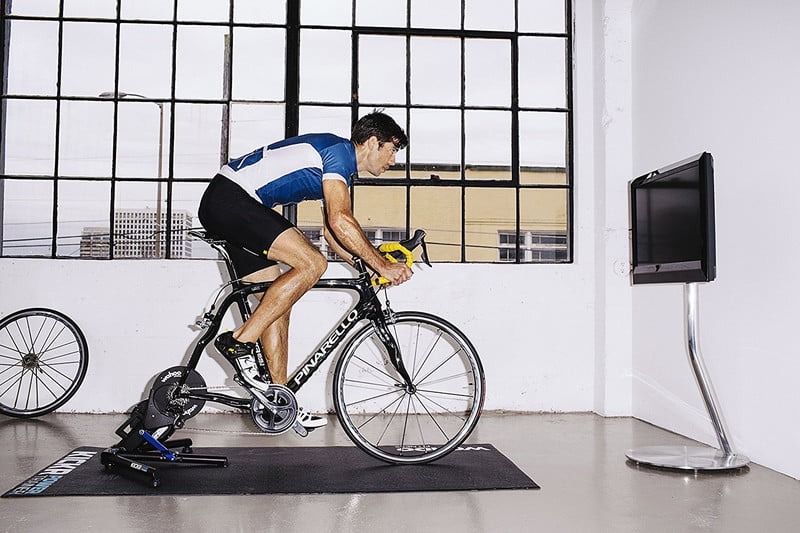
If the wintertime cold has you searching for the best way to stay in shape for long bike rides, or you just want a time-efficient and effective cardio workout to carve your legs to look like Lance Armstrong’s with a low-impact workout, the answer can be found in indoor cycling. It can also be your daily moment of Zen, a 20-minute workout that’s just as much a meditative act as it is a calorie-burner. But if you’re focusing on the results, says Denis Morton, a Peloton cycling and yoga coach in New York City, you’re thinking about it all wrong.
“Fitness is the goal, but along the way, the goal is to have fun,” Morton, 42, explains. “The more fun you can have with it, the more likely you are to stick to the routine, and the more likely you are to stick with it long-term.”
Whether you want to spend a couple of grand on a new bike or just want to dig your old 10-speed out of the garage, our spinning for beginners at home guide will get you cycling through miles in no time.
Finding The Right Training Space
Every practice starts with a space, but you don’t need bright light, blonde wood, and floor-to-ceiling mirrors to have a workable area “Indoor is in the title, so you’re going to want a space that’s indoors and sheltered,” Morton says. And that’s pretty much it.
Of course, there are some considerations that will make it better. Find a spot with a stable floor so as you hammer, you don’t tip over. You’ll also appreciate a non-porous surface so that when you dump buckets of sweat, you can wipe it clean and avoid lingering odors — anyone who’s been to a Bikram studio can tell you about the dangers of carpet. It’s better if you can keep your bike out of the way of your daily life activities, and it’s even better if it’s away from distractions like TV. Remember, this isn’t about mindlessly pedaling on a recumbent bike at the gym while you absentmindedly flip through a magazine. Finally, take stock of your environment and those around you, as a good workout can get a bit noisy. “If you have noise considerations, a downstairs roommate, or a family, you may want to keep it away from anyone that you might disturb and distract,” he says.
The clearance is not as bad as you might think. For most people, if you can stand up in the space and your fingers don’t touch the ceiling, it’s good enough. Plenty of basements and garages make effective (albeit not Instagram-worthy) indoor cycling spaces.
Finding The Right Bike
Exercise Bike

It’s in this category that you’ll have the greatest number of options. These days, the best exercise bikes run the gamut in terms of price and features, and most include their own ecosystem of workouts and trainers. But if you’re just starting out, you can use other bikes or even adapt your road bike.
Bike Trainer
If you are a cyclist or triathlete training in the offseason or simply prefer the feel of a real bike, you can use a bike trainer, which locks in the back wheel and allows it to spin so you don’t zoom into an apartment wall. And regardless of your price range, there’s a bike trainer that’s perfect for your needs.
Rollers

You can also use rollers, which essentially allow you to balance as you would on the roads for a more natural experience.
Trainers and rollers are usually cheaper than buying a dedicated exercise bike, and they require markedly less space than an entire spin setup. But they do have their drawbacks. Trainers can require more fiddling, adding time between you and your workout, and rollers are, to quote Morton, “super cool but a bit unstable.” In the end, a spin bike is the Apple of the indoor world: plug-and-play.
Regardless of your choice, any bike, within reason, will let you build strength, and ultimately it’s an individual decision. Of course, keep your eyes peeled, as exercise bike deals are more and more common as so many companies compete within the space.
Finding The Gear
“The most important accessory you can get are shoes and pedals that can keep you connected to the bike,” says Morton. Period. Full stop.
Specialized biking shoes, which attach to the bike’s crank arms via a screwed-in cleat to special “clipless” attachments, have several benefits. The first is your ability to transfer power. Those beat-up Vans you’ve been using on your beach cruiser are leaking power with every rotation, while a specialized shoe, which features a rigid plastic or carbon fiber base, puts more muscle into every revolution. There’s also the added benefit of attachment, which allows you to pull as well as push, applying energy into 360 degrees of movement. Trust us, it’s night and day better than anything else.
Beyond this, the best at-home workout gear includes a water bottle that’s easy to drink from, since a glass of water will spill everywhere. And a fan helps move air around, reducing sweating, while two towels, including one on the handlebars for your face and another nearby to wipe the bike and the floor, are a great addition. A stand for a tablet or phone, if you’re streaming workouts, is also handy, and Bluetooth, sweat-resistant headphones are a must for noisy homes so that you can tune in to your workout and tune out distractions.
Finally, a word on heart rate monitors. Options like the Scoche Rhythm+ , which mounts on your forearm, are great for green beginners to safeguard against going too hard. As a bonus, many fitness trackers can seamlessly integrate with new spinning bikes. “If you’re coming from a sedentary lifestyle it’s really important to be careful with yourself and pace yourself so you don’t overtrain,” Morton says. “Heart rate zone training can be really effective for that.”
Beginner Indoor Cycling Workouts

“Start where you can,” says Morton. For most, that means three to four workouts a week of 30 to 45 minutes each. Setting a routine, with specific days for your workouts, is also helpful, he adds. “Having those appointments in your head makes it easier for you to show up.”
It’s also important to pace yourself, and not just in the individual workouts, but also in their frequency. It is easy to do too much, too fast. “People get so excited in the beginning,” he says. “You get your new bike and you just want to jump on it every day and spend hours. But if you do that, there’s a chance both your body and your mind might overdo it early. And you don’t want to knock yourself off.”
Recovery, therefore, is king. A day off between workouts, at least at first, is highly recommended. Those days out of the saddle allow your body to replenish and rebuild, growing stronger for the next effort. As you build conditioning, you’ll be able to string together consecutive workdays, but for now, go slow. And a word from the wise: If you’re feeling flat or beat up, take a day off.
The Next Stroke
As you grow more and more comfortable with the workouts, there is a number of ways you can go. On the bike, you can branch into power zone training, which is based, at its most basic level, on levels of intensity. Once you perform an initial test, data can then be input into the Peloton app and applied to all workouts going forward, targeting your performance to achieve greater results. It can also act as a governor: “In power zone training, you avoid the possibility of overtraining, because it’s all custom fit to your level,” Morton says.
You can also add in other exercises to complement your time in the saddle. Yoga is a perfect opposite, stretching on the floor where you’ve been contracting on the bike, as well as improving balance and forward flexion, the latter of which helps develop more equal musculature. Strength training, even with bodyweight, has its benefits, as does a similar-yet-different cardio exercise like running, which can tax you differently. “What we really all want is to move better and feel comfortable in our own skin, and the more ways we move, the more comfortable we are with movement,” Morton says. “Being able to move your body is the joy of fitness.”



